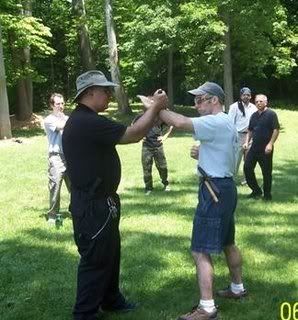 Bill McGrath, author of CFRB's book of the month, Asulon: Sword of Fire Book One, was kind enough to answer a few questions for me, shedding some light on himself and his novel.
Bill McGrath, author of CFRB's book of the month, Asulon: Sword of Fire Book One, was kind enough to answer a few questions for me, shedding some light on himself and his novel.1. Could you tell us a little about yourself. You know, the basic stuff, like where you live, where you come from, family, pets, etc.
I was born in 1960 in Queens, NY and grew up there. My wife, son and I live in a small town in upstate New York called Fishkill. We live on the edge of a forest and see deer, wild turkey, hawks or some other wild creature almost every day right outside our door.
I work for New York State as a court officer. If you remember the TV show “Night Court” from the 1980’s and the character “Bull” played by Richard Moll, well that’s me – same job, same haircut, only a bit shorter.
2. I understand you have a huge interest in martial arts and even teach it. What kind do you practice?
I’ve been practicing a Filipino martial art called Pekiti-Tirsia since 1975 and have been teaching since the early 80’s. Teaching has given me a chance to travel quite a bit as I conduct seminars throughout the U.S. and Europe. Pekiti-Tirsia is a weapons based art, so I get to use its techniques and principles in the sword fights in my novels. You can learn more about this art (and see some video demos) at my website: www.pekiti.com
3. Have you always wanted to be an author? What has been your writing experience so far?
When I was younger I wanted to be a full time martial arts instructor. I even tried it for a few years, but decided something more stable would be better if I wanted to have a family. Prior to Asulon my publishing history has been articles for martial arts and law enforcement magazines.
4. What influenced you to write the Sword of Fire novels?
I began writing the story in 1981. A friend had called and told me about the storyline of the movie “Omen III, The Final Conflict,” which he had just seen. Typically of Hollywood at that time when handling a biblical subject, the story had very little to do with what’s actually in scripture (in this case, regarding the Antichrist and the Second Coming of Christ). I reacted both as a Christian, “That’s not what the Bible says” and as a twenty year old guy, “I could write a better story than that.” So that’s what I set out to do. I decided to set the story of the tribulation and Second Coming in a fantasy setting, figuring that non-Christians would be more likely to read a biblical story if written that way. I wrote on and off for the next few years, getting about 120,000 word done, but stopped writing when my father died in 1986. I took up the story again in 2001 when my son was born. I wanted to write a story for him that brought together many of the things in the books I read as a teenager that gave me a life long love of reading and, I like to think, help point me in the right direction in life in general. What I envisioned as one book (The Sword of Fire) has now grown into three (Asulon, Eretzel and Apocalypse). The direct spark for my writing was to write a better story than The Omen, but the tinder, the fuel for my story was all the great books I read as a teen. Therefore, you’ll see influences in my story from authors such as J.R.R. Tolkien, C.S. Lewis, Dante Alighieri, Edmund Rostand, Alexander Dumas, James Fennimore Cooper, Edgar Rice Boroughs, Sir Arthur Conan Doyle, and Robert E. Howard.
5. I notice a serious inclusion of mythology in Asulon along with Biblical material. It reminds me of C. S. Lewis’ fiction. Do you have a penchant for mythology like he did?
I grew up watching all those great movies from the 40’s, 50’s and 60’s that had classical mythology at their base: Jason and the Argonauts, Ulysses, The Thief of Bagdad; even those low budget Hercules movies were a wonder to me. When I was a teen, I came across Bullfinch’s Mythology in the library and I was hooked. As a writer, I think Tolkien’s Silmarillion was more of an influence on me than Lewis. I liked how Tolkien “explained” the origins of the Greek gods in the Silmarillion and wanted to do something similar in my own work. What also helped was reading apocrypha, specifically the Book of Enoch, in which a third group of angels who tried to stay neutral during Satan’s rebellion were banished to earth as punishment for their neutrality. That’s the basis for the background of Anak the earthbound angel in my story.
6. I also noticed quite a few political ideas. Did you have a particular message or messages that you were trying to send with that?
I’m a Conservative in my political beliefs and a teacher by nature, so I wanted to teach some of the things I’ve learned about people and politics to the young people who are the target audience for my novels. I always recall my reaction on my first reading of Roman history and how the problems and issues of those days seemed so much like today, (usually the political elements in my stories that a reader will point to as being too much like this week’s headlines are the very ones I wrote more than twenty years ago and took directly from my reading of ancient history). My point is that mankind always seems to repeat the same mistakes over and over again. The political elements I have in my novels are my way of pointing this out to my readers and asking that they not make the same mistakes.
7. Could you give a summary of Asulon in your own words?
Asulon is the first book in my trilogy titled “The Sword of Fire.” My concept for The Sword of Fire was to tell the story of the Tribulation and the return of Jesus Christ in narrative form and to show the images from the related books of the Bible verbatim. That is, when Revelation tells of locusts with men’s faces and scorpion’s tails, that is what I show, rather than translate the locusts into attack helicopters, as some will do when setting their End Times story in the near future. I wanted to tell this story as a fantasy tale, because the images fit so well into a fantasy setting and because clothing a biblical tale in a fantasy story would get a Christian story in “under the radar” of people who would not normally read an overtly Christian novel.
In Asulon, I introduce my major characters (both good and bad), set up some of the major problems that get bigger in book two and reach a climax in book three.
8. In the beginning of the story, you gave a great deal of detail of Daniel hunting a deer and then dressing it afterwards. Have you done a lot of deer hunting yourself?
I’ve only been on one successful deer hunt and have much more experience with small game (when I was 20, there were a few months I spent in Arizona where I pretty much survived on Jackrabbit chili).
The opening scene in Asulon, where the wild country is thought of by Daniel with such affection, comes from my own days in the Boy Scouts and our monthly camping trips in the Catskill Mountains. I live next door to them now and they remain a very special place for me.
9. If you can tell it without too many spoilers, what would you like for readers to carry away from Asulon after they have read it?
One theme I wanted to explore in Asulon was what it means to be a godly warrior; to recall the Christian knights of the medieval tales. In the beginning of Asulon I give what I call the Paladin’s code (shown below).
The Warrior Virtues
DISCIPLINE
LOYALTY
COURAGE
HUMILITY
The Kingly Virtues
WISDOM
HONOR
CHARITY
JUSTICE
The Godly Virtues
FAITH
TRUTH
MERCY
LOVE
I use a phrase as a motto for the young warriors in Asulon that sums this all up. In Latin it is NOBILIS VOS ESTO. In English it is “Be Noble.” That is what I would like the reader to take away from Asulon. The desire to be noble.
Thank you so much for your time and such a wonderful interview. You've give us so much insight into your writing and the person that you are.
Some shots of Bill (in the floppy hat) during summer training with a Pekiti-Tirsia group. Much of the fighting in Asulon is similar to these demonstrations.






Websites for Bill McGrath:
1 comment:
Again, another good interview. I'm glad you asked some different questions than Melissa, and I'm glad that Bill didn't always cut and paste his replies to the questions you both asked.
One thing, THE SILMARILION, by J.R.R. Tolkien holds a special place in literature in that it was never meant to be published. Tolkien created an entire history of Middle Earth, starting before its creation. After his death, his son, Christopher, published these notes as THE SILMARILION. If any of you have seen or read this, you can truly appreciate the work that he put into THE LORD OF THE RINGS, because he never intended to publish THE SILMARILION.
Post a Comment